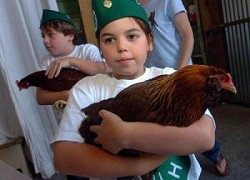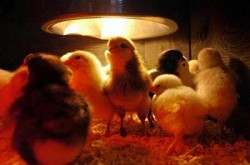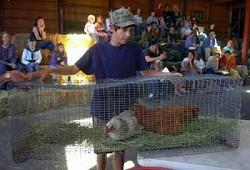Rob Rogers, Marin IJ link to article
May 30, 2009
Claire Cruse and her brother, Nicholas, hold Ruby and Maxine during the Backyard Chicken Workshop, a forum on raising chickens for egg production in your backyard, presented by the University of California Cooperative Extension at Toby's Feed Barn in Point Reyes Station. (IJ photo/Jeff Vendsel)
Baby chicks gather around a heat lamp in a display box during the "Backyard Chicken Workshop." (IJ photo/Jeff Vendsel)
Ryan Giammona of Point Reyes moves his cage with chickens onto a display table during the "Backyard Chicken Workshop," a workshop on raising chickens for egg production in your backyard, presented by the UC Cooperative Extension at Toby's Barn. (IJ photo/Jeff Vendsel)
It took some convincing on her daughter's part before Alexandra Matthews agreed to allow chickens in her Mill Valley backyard.
"I had my doubts," said Matthews, who has since helped both her daughters raise chickens as part of a 4-H project. "But my daughter is a total chicken expert. The chickens they chose - silkies - are not great egg-layers, but they're great pets.
"I'm crazy about chickens now," Matthews said.
Matthews was one of about 80 poultry lovers who attended Thursday's Backyard Chicken Workshop at Toby's Feed Barn in Point Reyes Station. The event, sponsored by the University of California Cooperative Extension in Novato, served as a primer for the growing number of families in Marin and elsewhere interested in welcoming fowl into their homes.
"It's been a phenomenon all the hatcheries are dealing with, in California, Oregon and New Mexico," said John Pellham of Western Farm Center in Santa Rosa. "I'll get chickens in on Fridays, 500 to 550 at a time, and they'll all be gone within five or six hours. We sold twice as many chickens this year as we did by this time last year."
With the exception of Tiburon, every city in Marin allows residents to raise eight or fewer chickens, provided there are no roosters. In Marin, the interest in chickens seems to tie in with the "slow food" movement's embrace of traditional methods of growing food, said Ellie Rilla, director of the extension's Marin office.
"I think a lot of people have become interested in local food production," Rilla said. "People like to know where their food is coming from."
They also like the opportunity to reconnect with the traditions of the past, said Bobby Foer. The Point Reyes Station resident began caring for chickens with the help of his grandfather while growing up in the San Geronimo Valley and now has a flock of about 90 birds.
"They were the only (animals) my mom allowed me to have," said Foer, one of four "chicksperts" to discuss chicken-raising techniques at Thursday's event. Foer went on to study poultry science at California Polytechnic State University, but became disillusioned when confronted with factory farming techniques.
"I suppose having caged birds is necessary in a way, but I wanted to do the more humane thing," said Foer, who was disturbed by the sight of chickens crammed into wire cages, with as many as eight cages stacked on top of each other. "The chickens had nails that were two inches long. I was told that was because they never got a chance to scratch."
Instead, Foer decided to raise his chickens the way his grandfather had, giving them space to roam around by day, a safe place to sleep at night and plenty of dark, secluded places to lay their eggs. As a result, he says, his birds are rarely sick and require little in the way of maintenance.
"They need warmth, dry litter, feed and space to move around," Foer said. "Once you learn how to feed them, they pretty much take care of themselves."
They're also productive, with each chicken generating about an egg a day. That productivity tends to depend on the breed, said Liz Cunninghame, who tends about 1,600 chickens on her 160-acre Star Route Farms in Tomales. Her chickens include Rhode Island reds and barred rocks - friendly, easy-to-care for chickens popular with many farmers - as well as leghorns, Amerucanas, which produce green eggs, and "sex links."
"With sex-linked chickens, you match a particular rooster with a particular hen, and you get chicks that come out a certain color," Cunninghame said.
Cunninghame uses an electric fence and several guard dogs to protect her chickens from predators, including bobcats, coyotes, foxes and eagles. For most suburban chicken farmers, the danger comes from raccoons or weasels, Pellham said.
"Predators are my number one salesmen," Pellham joked. "The majority of my customers are people replacing their flock."
Most chickens would do better, Pellham said, if their owners spent just a little more time learning how to take care of them. To that end, Thursday's panel of experts handed out advice from the arcane - it's possible to tell what color a chicken's eggs will be by looking at the color of a chicken's earlobes - to the practical: feeding chickens oyster shells gives them calcium, which prevents thinness in their own eggshells.
Pellham, who recommends a flock of about six to nine chickens for a family of four, had another word of advice for those who would raise them.
"My advice is don't name your chickens," Pellham said. "Things happen to them. It's hard, but that's part of nature."






